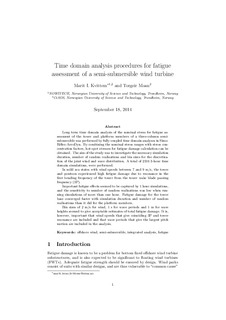Time domain analysis procedures for fatigue assessment of a semi-submersible wind turbine
Journal article, Peer reviewed
Permanent lenke
http://hdl.handle.net/11250/2389427Utgivelsesdato
2015Metadata
Vis full innførselSamlinger
- Institutt for marin teknikk [3397]
- Publikasjoner fra CRIStin - NTNU [37186]
Sammendrag
Long term time domain analysis of the nominal stress for fatigue as-
sessment of the tower and platform members of a three-column semi-
submersible was performed by fully coupled time domain analyses in Simo-
Ri
ex-AeroDyn. By combining the nominal stress ranges with stress con-
centration factors, hot spot stresses for fatigue damage calculation can be
obtained. The aim of the study was to investigate the necessary simulation
duration, number of random realisations and bin sizes for the discretisa-
tion of the joint wind and wave distribution. A total of 2316 3-hour time
domain simulations, were performed.
In mild sea states with wind speeds between 7 and 9 m/s, the tower
and pontoon experienced high fatigue damage due to resonance in the
rst bending frequency of the tower from the tower wake blade passing
frequency (3P).
Important fatigue e ects seemed to be captured by 1 hour simulations,
and the sensitivity to number of random realisations was low when run-
ning simulations of more than one hour. Fatigue damage for the tower
base converged faster with simulation duration and number of random
realisations than it did for the platform members.
Bin sizes of 2 m/s for wind, 1 s for wave periods and 1 m for wave
heights seemed to give acceptable estimates of total fatigue damage. It is,
however, important that wind speeds that give coinciding 3P and tower
resonance are included and that wave periods that give the largest pitch
motion are included in the analysis.
